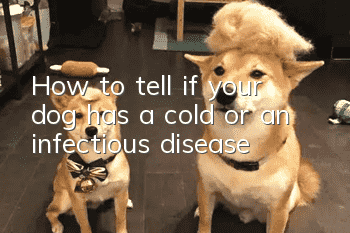How to tell if your dog has a cold or an infectious disease?

The early symptoms of dog infectious diseases are very similar to those of a cold. For example, the early symptoms of warm fever in dogs and the early symptoms of parvovirus disease are generally clinically characterized by elevated body temperature, sneezing, blurry eyes, and watery nasal discharge. Due to lack of experience, some owners tend to treat several common serious infectious diseases as colds, thus causing misdiagnosis and wrong treatment measures, leading to serious consequences of the death of their dogs.
Fake colds are generally more common in the early stages of infectious diseases. In fact, there are other special symptoms. When a dog is infected with the dog warm virus and becomes ill, the body temperature is generally bidirectional, with the body temperature rising and falling. Most sick dogs have symptoms of eye droppings. In the early stage of parvovirus, it is mainly accompanied by major symptoms such as vomiting and diarrhea, and usually vomiting first and then diarrhea. As long as the owner can observe carefully, he can still distinguish and judge.
Symptoms of colds in dogs:
1. Not in good spirits and always want to sleep
Dogs are generally very active , the energy is relatively strong, but when it catches a cold, it will be depressed and not in good spirits. It always lies on the ground motionless, gets sleepy easily, is always sleeping, and feels like it cannot wake up.
2. Runny nose
Dogs will also have a runny nose when they are sick. When they have a cold, the nose will always be watery and transparent. If the nasal mucus is pus-like, please note that it may be canine distemper, and you should go to the pet hospital for treatment in time. It should be noted that you must help your dog clean up his nose in time to prevent loss of appetite caused by nasal congestion.
3. Coughing and sneezing
Dogs will have symptoms of sneezing and coughing after catching a cold. It will be difficult to swallow food, they will feel throat discomfort, and they may also vomit. Appear.
4. Decreased appetite
Under normal circumstances, dogs have a good appetite and can eat a lot of things. Once they catch a cold, their appetite decreases, and even their favorite food The little snacks don’t arouse any interest.
5. Body heat and body temperature rise
The body temperature of dogs is higher than ours. The normal body temperature of puppies is 38.5~39℃, and the normal body temperature of adult dogs is 37.5~ 38.5℃, the owner can touch the dog's inner thigh to see if it is particularly hot. If it is hotter than usual, the dog's rectal temperature can be measured directly.
- What to do if your dog’s hair becomes tangled?
- Symptoms and treatment of parvovirus in Bichon Frize
- An in-depth analysis of five common dog behaviors
- What should I do if my golden retriever chews the furniture at home? Dog owners, look over here!
- Prevent your dog’s five major health risks
- How do novices raise Corgis? Daily feeding methods for Corgis!
- How much does a French Bulldog cost? French Bulldog Price!
- What is the purpose of the Canaan Dog?
- What to pay attention to when buying a Teddy puppy
- How to treat dog skin ulcers



